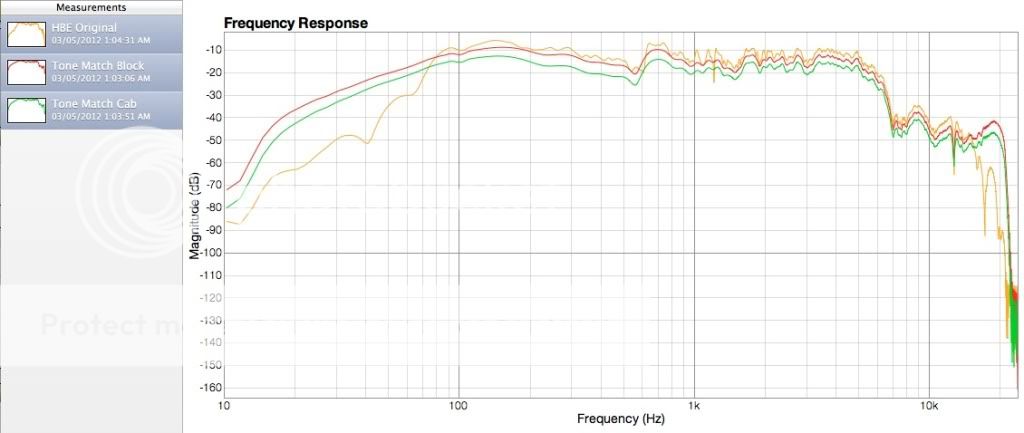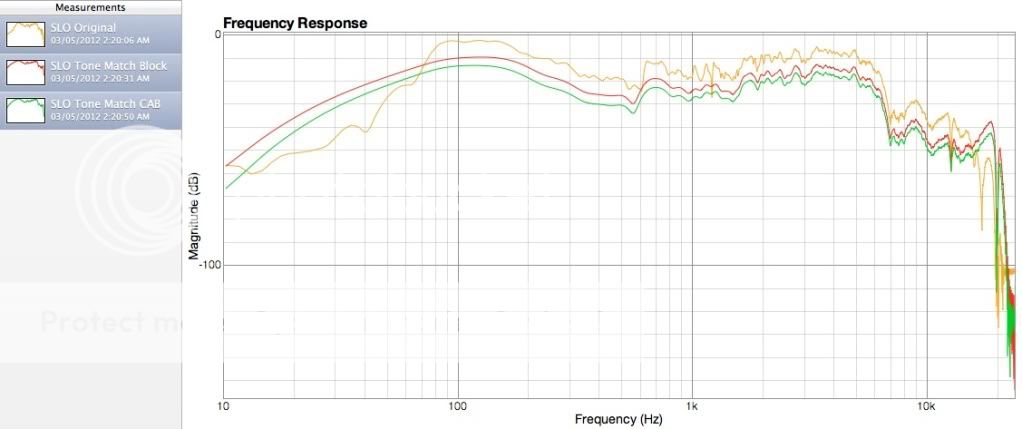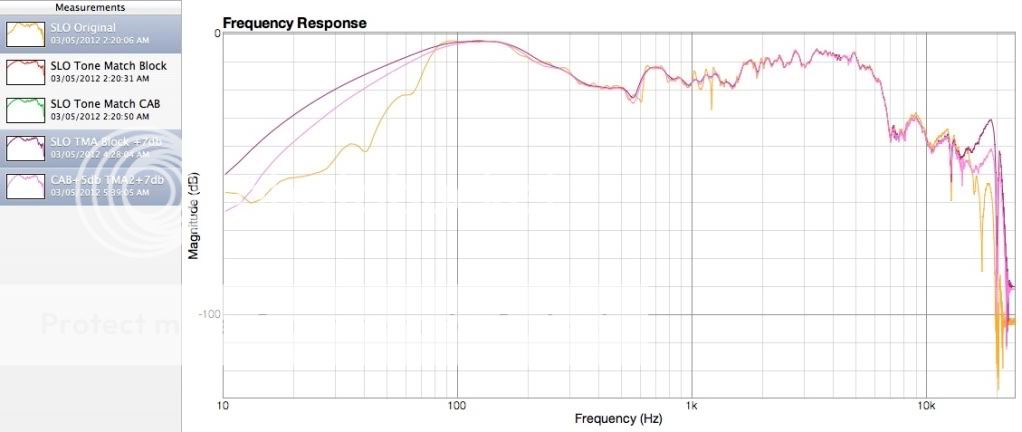npx
Inspired
After having a bit of a play with V6 tone matching, I found my most accurate matches were obtained when I applied a high pass blocking filter at 80Hz after the TMA block.
Just for my own curiosity I ran a frequency analysis (using FuzzMeasure for OS X) to compare between the original, TMA block and exported User Cab versions of a basic tone match. I hadn't intended posting the results, but I figure a few of you might be interested so I did a few more comparisons. (Apologies if someone has posted something similar before, I did a quick search but found nothing.)
For consistency, I recorded some DI guitar over usb and re-amped it through a basic HBE patch (Drive 7 Master 9 Presence 5) and an 4x12 SLM M75 (OH) cab for the original.
An easy tone match patch was made by dropping the Presence to 0, adding a TMA block instead of the cab and using the same DI guitar for the local capture signal.
ORANGE is the original HBE tone
RED is the Tone Match block version
GREEN is with a User Cab exported from that Tone Match block.

Here is the same thing using an SLO 100 LEAD amp block on default settings. (Presence on 5 for the original patch and 0 to create the matched version.)

By adding +7db to the level of the TMA block to bring it up to equal loudness with the original patch, the added bass response is more obvious. Also notable is the extra energy around the 11kHz area.

As you can see, the resulting match is very accurate within the usual electric guitar range of 80Hz to 10.5k, but a little less so outside of that. I haven't tried to tone match any basses yet, but I imagine the less accurate low end response may come into play there.
Lastly, I exported the matched SLO block to a user cab, added a new TMA block after it and did a second tone match. To get the level the same on the graph I needed to boost the cab block +5db as well as +7db on the TMA block. The result is in PINK.

The new EQ curve is slightly closer to the original in the areas that were most askew before, but almost exactly the same in the main guitar range.
Although the 3 patch levels now match on the graph, the pink double tone matched one is audibly slightly louder. When that patch is exactly the same level to my ear, its plot on the graph is below the others. Maybe a very subtle compression results from a smoothing algorithm in the tone matching process, and in turn is magnified by the double helping??
Anyway, food for thought.
Just for my own curiosity I ran a frequency analysis (using FuzzMeasure for OS X) to compare between the original, TMA block and exported User Cab versions of a basic tone match. I hadn't intended posting the results, but I figure a few of you might be interested so I did a few more comparisons. (Apologies if someone has posted something similar before, I did a quick search but found nothing.)
For consistency, I recorded some DI guitar over usb and re-amped it through a basic HBE patch (Drive 7 Master 9 Presence 5) and an 4x12 SLM M75 (OH) cab for the original.
An easy tone match patch was made by dropping the Presence to 0, adding a TMA block instead of the cab and using the same DI guitar for the local capture signal.
ORANGE is the original HBE tone
RED is the Tone Match block version
GREEN is with a User Cab exported from that Tone Match block.

Here is the same thing using an SLO 100 LEAD amp block on default settings. (Presence on 5 for the original patch and 0 to create the matched version.)

By adding +7db to the level of the TMA block to bring it up to equal loudness with the original patch, the added bass response is more obvious. Also notable is the extra energy around the 11kHz area.

As you can see, the resulting match is very accurate within the usual electric guitar range of 80Hz to 10.5k, but a little less so outside of that. I haven't tried to tone match any basses yet, but I imagine the less accurate low end response may come into play there.
Lastly, I exported the matched SLO block to a user cab, added a new TMA block after it and did a second tone match. To get the level the same on the graph I needed to boost the cab block +5db as well as +7db on the TMA block. The result is in PINK.

The new EQ curve is slightly closer to the original in the areas that were most askew before, but almost exactly the same in the main guitar range.
Although the 3 patch levels now match on the graph, the pink double tone matched one is audibly slightly louder. When that patch is exactly the same level to my ear, its plot on the graph is below the others. Maybe a very subtle compression results from a smoothing algorithm in the tone matching process, and in turn is magnified by the double helping??
Anyway, food for thought.

